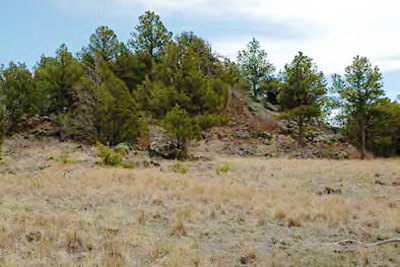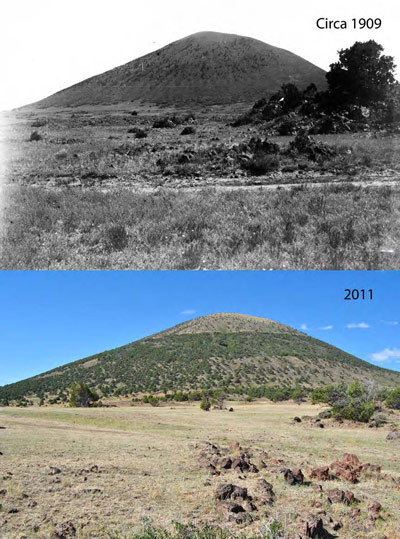Pinyon-juniper is one of the major habitat types found within Capulin Volcano National Monument and comprises approximately 59% of the monument’s total area.

NPS photo
Pinyon pine (Pinus edulis) and Rocky Mountain juniper (Juniperus scopulorum), or pinyon-juniper, habitats have considerable value to wildlife. This habitat provide cover, particularly during the winter, for large mammals such as mule deer (Odocoileus hemionus) and elk (Cervus elaphus), and food in the form of pinyon nuts and juniper berries for many bird species, including the Pinyon Jay (Gymnorhinus cyanocephalus). Pinyon-juniper habitats also contribute to biological diversity in other ways. For example, along the monument’s east crater rim a distinctive community of well-developed foliose lichens grow. These lichens are relatively uncommon and are only found on a few isolated mountain tops in New Mexico where clouds and mist provide moisture to support their growth.
Status and Trends

Photos by USGS (top) and Jonathin Horsley (bottom)
There are four types of pinyon-juniper habitat throughout the monument including persistent pinyon-juniper woodland, pinyon-juniper shrubland, pinyon-juniper savanna, and pinyon-juniper persistent woodland patches interspersed among grassland. Through repeat photography analysis of photos from the early 1900s to present day, as well as interviews with long-time local residents, it is evident that pinyon-juniper habitats were present on the cone, and even well established in some areas (for example on the south and east sides of the cone), at least since the turn of the century. A fire study conducted within the monument revealed that out of seven trees examined along the cinder cone, no fire scars for a 250-year period (1790-2004) could be found. In fact, some trees sampled were at least 485 years old, indicating the presence of pinyon for quite some time. Pinyon-juniper experts visited the monument to assess the overall condition of all four pinyon-juniper habitat types. They determined the overall condition was good, and that the species present, age class distributions, stand densities, and current level of insects or diseases were all within the normal range of variability for the monument’s pinyon-juniper habitats.
Discussion
Pinyon-juniper habitat, in general, has often been misunderstood as being an “unnatural” habitat that has degraded other habitats, such as grasslands, by infilling previously unoccupied areas. This has been the prevailing view for some time for the monument’s pinyon-juniper habitat, but based on recent information and discussions with researchers who have studied this plant community throughout the United States, it is believed that the pinyon-juniper habitat types throughout the monument are healthy systems, supporting a wide variety of native plants and animals that helps make the monument a truly unique area.
For More Information
Bennetts, R. E., K. Struthers, P. Valentine-Darby, T. Folts, H. Sosinski, and E. Yost. 2011. Capulin Volcano National Monument: Natural Resource Condition Assessment. Natural Resource Report NPS/SOPN/NRR—2012/492. National Park Service, Fort Collins, Colorado.
Prepared by the Southern Plains Network Inventory and Monitoring Program, 2012.
Last updated: February 4, 2015
